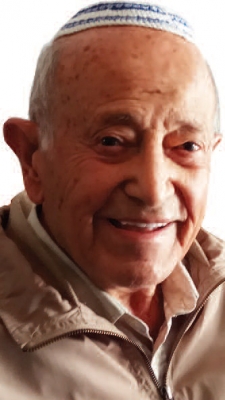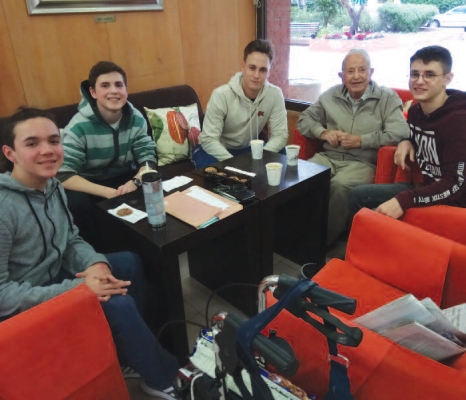Profile of Sion Mehdi
How a nice Jewish boy of Persian descent ended up mixing with the Royals
Few people don't recognize the: "Orrrder ... orrrder" of John Bercow, former Speaker of the house in England's parliament.
If you ever join us at Beth Protea for Friday night Shabbat dinner, we have our own very effective caller for order as Sion Mehdi loudly exclaims "Kiddush" before he blesses the wine and bread, always with a smile on his face and a cheerful greeting of "Shabbat shalom". What is the story behind this man?
With great pride and delight, Sion brought a recent edition of ESRAmagazine into the dining room one day, opened on an article about youth villages in Israel, with a referral address of Dahlia Mehdi, Chief executive of Youth Aliyah child rescue in London. Proudly, he identified Dahlia as his daughter whom he explained had been appointed to the position he had formerly held in London and she was making a great success of it. And so a portal into his interesting life opened and I was mesmerized by what felt like a journey into an Arabian nights' fairy tale.
Sion's parents were born in Persia and came to Israel in 1901 at the time of the Ottoman empire. The family were Marshadis - coming from Marshad which is on the North Eastern border of Persia - on the silk route. In 1845, the Jewish community were all converted en masse to Islam at the point of a sword - however, the Jews went underground and Judaism grew stronger. They were known as the "Anusim Marshad". This community fled from the Shiites to Bucharia and then spread all over the world keeping Judaism alive. Even the Jews of Kaifeng in India were part of the Marshadi community. In July 1932 Sion was born in Jerusalem in the Bucharian quarter. His father battled to make a living, being the only Jew with an antique shop inside the Zion Gate of Jerusalem. When Sion was two years old the Mehdi family, mother, father, daughter and son, left for Europe seeking lucrative opportunities. His father was a world expert on Oriental carpets and their efforts took them to one country after another for two years. In 1936 they joined a strong Persian community in London where Sion completed his schooling followed by a stint at the City of London University attending lectures with BSc and BCom students. He had no interest in getting a degree - he just wanted the knowledge to guide him into business and after 18 months he left university and joined his father in trade.
The Spanish / Portuguese were the aristocrats of the Jewish community in London and they used to run prestigious youth clubs. From the day he started working, the youth clubs became Sion's passion. In no time he progressed to being a leading force in the organization. He refers to the 4-storey social center they built in Stanford Hill called the Victoria Boys and Girls club, housing restaurants, gymnasiums, a rooftop basketball court and an outdoor football field on ground next door hired from the local authority. His involvement there got him elected to represent the club on the committee of the Association for Jewish Youth, an umbrella organization assisting every Jewish Youth movement which involved 40,000 children, training youth leaders, holding seminars, educational programs and other activities.He served as Honorary Secretary for many years and then progressed to representation on the Board of Deputies for the AJY (Association for Jewish Youth) where he was soon co-opted onto the Youth and Education Committee which he headed for nine years.
On one journey to Persia, which was a regular trip for his work with his father, Sion met Minna, the lady who was to become his wife. They got engaged a month after first meeting and he extended his business trip in order to wed in Teheran a month later, surrounded by family and friends still living in Persia. Sion then brought his new bride to London to meet his parents and to adjust to life in the Western world. They had three children, two boys and a girl, who grew up in London. Tragically when their eldest son was 17 and the youngest boy still at primary school Minna was killed in a freak car accident.
The children were used to their father being a workaholic. After a full day in the shop he officiated at the youth committees he worked on. He recalls the children telling him he had a medical condition called "committee-itis".
His prominence in the committees he had served on led to him being invited to meet with Royalty a number of times. He had the honor of being presented personally to the Queen on three different occasions following on his first invitation to the Buckingham Palace Garden party as an Executive of the British Board of Deputies. A prestigious occasion at Hampton Court saw him with his daughter Dahlia, then only 16, accompanying him to be presented to Prince Charles and Princess Diana. On different auspicious occasions he was also presented to Princess Anne and Prince Edward.
Sion proudly admits keeping his Persian nationality for himself and his whole family, wherever his life took them. He in fact has a unique passport, an Islamic Republic of Iran passport issued to a Jew, born in Jerusalem. It was only when the Shah was deposed that Sion was granted British naturalization. And this nice Jewish boy of Persian descent, recognized as an Iranian who ran a Persian carpet shop in Cheapside, London City, for many years met almost all the British Royal family. What a story!
When Sion's father retired and left for Israel, Sion closed the business in London and devoted all his time to his passion for the Youth Aliyah child rescue committee, where he subsequently worked as a fundraiser for 13 years and as director of the organization in England. His position entailed him collecting wish lists from the villages in Israel, whether for a pool, a sports ground, etc. He would approach contacts in England to sponsor such requirements. His lovely sense of humor comes to the fore as he explains that he had a wonderful job - he got a salary to spend other people's money. He loved his work. It involved ultimately satisfying the needs and giving opportunities to at-risk children from challenged backgrounds for education, guidance, support, and acceptance.
After he himself retired, Sion returned home to Israel and settled in Netanya. He kept in weekly telephone contact with his former workplace in Britain to report on the youth aliyah villages they supported, and which he visited regularly.
Sion sought a practical way to remain connected with his passion for the youth.Directors of the youth aliyah villages in Israel suggested that he stay involved by helping the children in the youth villages with their English. His reaction to this suggestion was the following: "I will do so on two conditions: one, it should be fun, I come as a volunteer, I am not a teacher, but have been involved with youth and education all my life - I want it to be fun so that I can enjoy it and so can the children; two, I want to be paid two bottles of coke and two cakes every time I come to share with the pupils".
The arrangement was sealed. At the time Sion still had a car and he visited four villages, a different one each day: Yemin Orde situated near Haifa, Neve Hadassah in Netanya, TOM (Torah O Meida - Torah and Science) and Aloney Yitzhak in Benyamina. In time he gave up his car but not his volunteering and travelled to the schools by train or bus, slowing down when he reached 80-years-old. Two years later he was invited to light the first candle for Chanukah at Aloney Yitzhak which had been his privilege for many years. He attended the event but declined the honor. After being welcomed and introduced, one of the boys, completely unknown to him, approached him and asked him to consider coming back as a tutor in English.Because of that child Sion decided he still had the interest and energy to do so and for the next six years he did exactly that, visiting Aloney Yitzhak and TOM. Today he still visits TOM (religious village for boys) where they are also taught practical subjects preparing them for life in Israel today. He loves mixing with these students, all with kippot, peyot and tsitstit while casually attired in jeans and t shirts - the modern Israel - and the way to go in his opinion.
The boys of Neve Hadassah missed Sion's visits and to serve their needs their director, Nahum, brings four boys to see Sion once a week for an hour. They can be seen huddled together with him around the table deep in English conversation. A group of buddies communicating avidly and having fun together.
Sion has made Beth Protea his home and with his zest for living and enriched by his lovely sense of humor and his religious observance and faith, he is serenely enjoying new adventures in the tapestry that is his life.











Comments